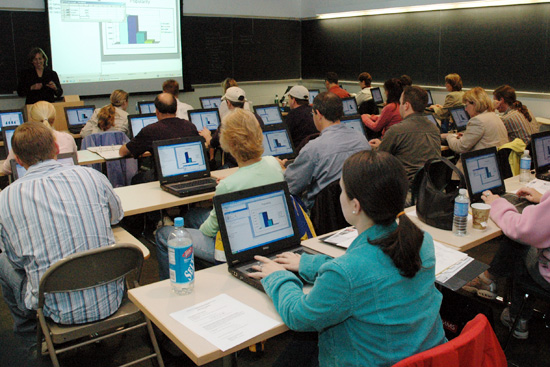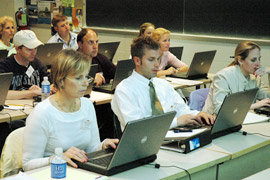Connecticut Math Teachers Benefit from Leadership Academy
 |
|
Beth Redington, project coordinator, teaches Connecticut teachers how to implement Microsoft PowerPoint presentations into their classroom instruction during the Leadership Academy in Mathematics Program May 19 in Exley Science Center. |
| Posted 05/28/06 |
| Jennifer DaPonte, a mathematics teacher from Flood Middle School in Stratford, Conn. went back to college May 19 to learn advanced geometry and story problems.
Im here to learn more about specific topics that relate to my schools curriculum, DaPonte says. It would be helpful to learn how to better teach geometry, statistics, data analysis and general problem solving skills.  DaPonte is one of 50 middle and high school teachers of mathematics participating in the Leadership Academy in Mathematics Program. This 18-month-long program was designed to create a cadre of leaders in each of the 13 partner school districts involved. Wesleyans Project to Increase Mastery of Mathematics (PIMMS) and Science and Southern Connecticut State University (SCSU) are collaborating on the project. DaPonte is one of 50 middle and high school teachers of mathematics participating in the Leadership Academy in Mathematics Program. This 18-month-long program was designed to create a cadre of leaders in each of the 13 partner school districts involved. Wesleyans Project to Increase Mastery of Mathematics (PIMMS) and Science and Southern Connecticut State University (SCSU) are collaborating on the project.
The program is funded by two grants from the Mathematics and Science Partnership Program of the Connecticut State Department of Education. We want to train Connecticuts best teachers to be even better teachers, says Mike Zebarth, director of PIMMS and coordinator of the Leadership Academy in Mathematics Program. Not all teachers of mathematics are specialized in math. We want to provide them with a stronger background in math so they can go on to be great leaders.Each participant will receive a $1,200 stipend, a laptop computer and six graduate credits through Wesleyans Graduate Liberal Studies Program. They will attend a two week summer program at Ansonia High School and three weekend workshops at Wesleyan and SCSU. The initial workshop was held in Exley Science Center on May 19 and 20. Each participant in the workshop received software packages including Microsoft PowerPoint and Excel. Participants were trained how to use these programs as instructional tools. I used PowerPoint in college for projects, and a little Excel, but I never used either one for teaching before, DaPonte said, during a lesson on Power Point. Id like to integrate the technologies into classroom instructions. After completing the program, the teachers will train other teachers at their schools. The programs success will be measured by the participants student achievements. Academy leaders will see if students who are taught by trained teachers do better on the Connecticut Mastery Test and Connecticut Advanced Placement tests. Zebarth says Wesleyan sponsors outreach programs like this to improve Connecticuts teachers, which will provide more learning opportunities for the states students. He also hopes the states top high school students will apply to Wesleyan and enroll in a math or science program. Wesleyan is community minded, and we take a vested interested in the citizens of the state, he says. |
| By Olivia Drake, Wesleyan Connection editor |

